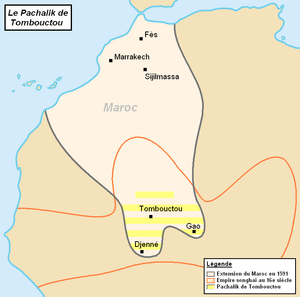Pashalik of Timbuktu
| Pashalik of Timbuktu باشوية تمبكتو Bashauyat Timbuktu | |||||
| Pashalik of Morocco | |||||
| |||||
 | |||||
| Capital | Timbuktu | ||||
| Government | Moroccan Pashalik (1591–1603) Nominally vassal state of Morocco (1603–1826) Tributary state of the Tuaregs (1787–1833) | ||||
| History | |||||
| • | Established | 1591 | |||
| • | Disestablished | 1833 | |||
| Today part of | Mali | ||||
Part of a series on the |
|---|
| History of Azawad |
The Pashalik of Timbuktu was a West African political entity that existed between the 16th and the 19th century.
History
By the end of the 16th century, Moroccan sultans were strengthened after the completion of the reunification of Morocco and the victory over the Portuguese at the Battle of the Three Kings, but their financial needs lead them to extend their realm southward to Saharan gold mines and Songhay territories.[1]
In 1577, a Moroccan expedition occupied Taghaza. In 1582, a first expedition to Timbuktu was defeated.
In 1591, a Moroccan expeditionary force defeated the Songhay army at Tondibi and conquered Gao, Timbuktu and Djenné. The Pashalik of Timbuktu was then established and Timbuktu became its capital.
Starting from 1618, the Pasha, who was then appointed by the Sultan of Morocco, became elected by the Armas.[2] However, while governing the Pashalik as an independent republic, the Armas continued to recognize Moroccan sultans as their leaders. During the civil war that followed the death of Ahmad al-Mansur in Morocco, the Pashalik supported the legitimate Sultan, Zidan al-Nasir,[3] and in 1670 they recognized the Alaouite sultans and pledged allegiance.[4]
By the middle of the eighteenth century, the pashalik was in total eclipse. In about 1770, the Tuareg took possession of Gao, and in 1787 they entered Timbuktu and made the Pashalik their tributary.[5]
See also
References and Bibliography
References
- ↑ R. Davoine (2003), p.36
- ↑ B.A. Ogot (1992), p.307
- ↑ J.D. Fage (1975), p.155
- ↑ B.A. Ogot (1992), p.315
- ↑ J.D. Fage (1975), p.170
Bibliography
- Elias N. Saad (1983). Social History of Timbuktu The Role of Muslim Scholars and Notables, 1400-1900. Cambridge University Press. ISBN 978-0-521-24603-3.
- Fage, J.D.; Gray, Richard; Oliver, Roland (1975). The Cambridge History of Africa. Cambridge University Press. ISBN 978-0-521-20413-2.
- N. Levtzion, Chp. III - North-West Africa: from the Maghrib to the fringes of the forest, pp. 142–222
- The pashalik of Timbuktu, pp. 152–158
- Timbuktu, Jenne and Massina under the Arma, pp. 158–164
- The Arma, Songhay and Tuareg, pp. 165–171
- The Bambara states, pp. 171–182
- N. Levtzion, Chp. III - North-West Africa: from the Maghrib to the fringes of the forest, pp. 142–222
- Grémont, Charles (2010). Les Touaregs Iwellemmedan, 1647-1896 un ensemble politique de la boucle du Niger. KARTHALA Editions. ISBN 978-2-8111-0397-2.
- Chp. III - Karidenna, ancêtre historique et figure emblématique (1647–1713), pp. 149–212
- Chp. IV - Les Iwellemmedan au XVIIIe siècle: émergence d'une entité politique, pp. 213–290
- M. Abitbol, Tombouctou et les Arma: de la conquête marocaine du Soudan nigérien en 1591 a l'hégémonie de l'Empire peul du Macina en 1833, Ed. Maisonneuve et Larose, 1979. (ISBN 2706807709)
- B. Rosenberg, Michel Abitbol, Tombouctou et les Arma. De la conquête marocaine du Soudan nigérien en 1591 à l'hégémonie de l'Empire Peulh du Macina en 1833 (compte rendu), in: Annales. Économies, Sociétés, Civilisations 37(4), 1982, pp. 833–836
- Bethwell A. Ogot (1992). Africa from the Sixteenth to the Eighteenth Century. UNESCO. ISBN 978-92-3-101711-7.
- M. Abitbol, Chp. XI - The end of the Songhay empire, pp. 300–326
- Davoine, Robert (2003). Tombouctou fascination et malédiction d'une ville mythique. L'Harmattan. ISBN 978-2-7475-3939-5.